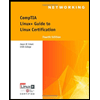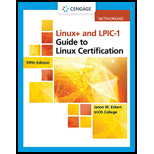
Mindtap Networking, 2 Terms (12 Months) Printed Access Card For Eckert's Comptia Linux+ Guide To Linux Certification, 4th
4th Edition
ISBN: 9781337780629
Author: Jason Eckert
Publisher: Cengage Learning
expand_more
expand_more
format_list_bulleted
Concept explainers
Expert Solution & Answer
Chapter 5, Problem 1RQ
Program Description Answer
“parted” is the command that is used to create partitions on hard disks.
Hence, correct answer is option “D”.
Expert Solution & Answer
Explanation of Solution
“parted” command:
- In Linux
operating system , the “parted” command is a well-known command line tool that allows the user to easily manage hard disk partitions. - It helps to create partitions on either MBR or GPT hard disks.
- With the use of this command user can add, delete, shrink and extend the disk partitions along with the file systems that are located on them.
- It is also known as GNU parted command.
Want to see more full solutions like this?
Subscribe now to access step-by-step solutions to millions of textbook problems written by subject matter experts!
Students have asked these similar questions
4. |z + 5 - 5i| = 7
14.
dz,
C: |z❘
C: |z❘ = 0.6
ze² - 2iz
H
14.
dz,
C: |z❘
C: |z❘ = 0.6
ze² - 2iz
H
Chapter 5 Solutions
Mindtap Networking, 2 Terms (12 Months) Printed Access Card For Eckert's Comptia Linux+ Guide To Linux Certification, 4th
Ch. 5 - Prob. 1RQCh. 5 - After a partition on a hard disk is formatted with...Ch. 5 - Prob. 3RQCh. 5 - Prob. 4RQCh. 5 - Prob. 5RQCh. 5 - A user mounts a device to a mount point directory...Ch. 5 - Which command is used to display the amount of...Ch. 5 - What must you do to successfully run the fsck...Ch. 5 - Character devices typically transfer data more...Ch. 5 - What does the du /var command do? a. shows the...
Ch. 5 - Prob. 11RQCh. 5 - Prob. 12RQCh. 5 - Which of the following statements are true?...Ch. 5 - Prob. 14RQCh. 5 - Which of the following statements regarding LVM...Ch. 5 - Prob. 16RQCh. 5 - You plug a USB flash memory drive into a system...Ch. 5 - Which command mounts all existing filesystems in...Ch. 5 - Prob. 19RQCh. 5 - Which command is used to format a partition on a...
Knowledge Booster
Learn more about
Need a deep-dive on the concept behind this application? Look no further. Learn more about this topic, computer-science and related others by exploring similar questions and additional content below.Similar questions
arrow_back_ios
SEE MORE QUESTIONS
arrow_forward_ios
Recommended textbooks for you
 CompTIA Linux+ Guide to Linux Certification (Mind...Computer ScienceISBN:9781305107168Author:Jason EckertPublisher:Cengage Learning
CompTIA Linux+ Guide to Linux Certification (Mind...Computer ScienceISBN:9781305107168Author:Jason EckertPublisher:Cengage Learning LINUX+ AND LPIC-1 GDE.TO LINUX CERTIF.Computer ScienceISBN:9781337569798Author:ECKERTPublisher:CENGAGE L
LINUX+ AND LPIC-1 GDE.TO LINUX CERTIF.Computer ScienceISBN:9781337569798Author:ECKERTPublisher:CENGAGE L A+ Guide To It Technical SupportComputer ScienceISBN:9780357108291Author:ANDREWS, Jean.Publisher:Cengage,
A+ Guide To It Technical SupportComputer ScienceISBN:9780357108291Author:ANDREWS, Jean.Publisher:Cengage, EBK JAVA PROGRAMMINGComputer ScienceISBN:9781337671385Author:FARRELLPublisher:CENGAGE LEARNING - CONSIGNMENTProgramming Logic & Design ComprehensiveComputer ScienceISBN:9781337669405Author:FARRELLPublisher:Cengage
EBK JAVA PROGRAMMINGComputer ScienceISBN:9781337671385Author:FARRELLPublisher:CENGAGE LEARNING - CONSIGNMENTProgramming Logic & Design ComprehensiveComputer ScienceISBN:9781337669405Author:FARRELLPublisher:Cengage Microsoft Visual C#Computer ScienceISBN:9781337102100Author:Joyce, Farrell.Publisher:Cengage Learning,
Microsoft Visual C#Computer ScienceISBN:9781337102100Author:Joyce, Farrell.Publisher:Cengage Learning,

CompTIA Linux+ Guide to Linux Certification (Mind...
Computer Science
ISBN:9781305107168
Author:Jason Eckert
Publisher:Cengage Learning

LINUX+ AND LPIC-1 GDE.TO LINUX CERTIF.
Computer Science
ISBN:9781337569798
Author:ECKERT
Publisher:CENGAGE L

A+ Guide To It Technical Support
Computer Science
ISBN:9780357108291
Author:ANDREWS, Jean.
Publisher:Cengage,

EBK JAVA PROGRAMMING
Computer Science
ISBN:9781337671385
Author:FARRELL
Publisher:CENGAGE LEARNING - CONSIGNMENT

Programming Logic & Design Comprehensive
Computer Science
ISBN:9781337669405
Author:FARRELL
Publisher:Cengage

Microsoft Visual C#
Computer Science
ISBN:9781337102100
Author:Joyce, Farrell.
Publisher:Cengage Learning,
Linux - Tutorial for Beginners in 13 MINUTES! [ UPDATED ]; Author: bai;https://www.youtube.com/watch?v=BMGixkvJ-6w;License: Standard YouTube License, CC-BY
What is Linux?; Author: Techquickie;https://www.youtube.com/watch?v=zA3vmx0GaO8;License: Standard YouTube License, CC-BY
Introduction to Linux and Basic Linux Commands for Beginners; Author: sakitech;https://www.youtube.com/watch?v=IVquJh3DXUA;License: Standard Youtube License